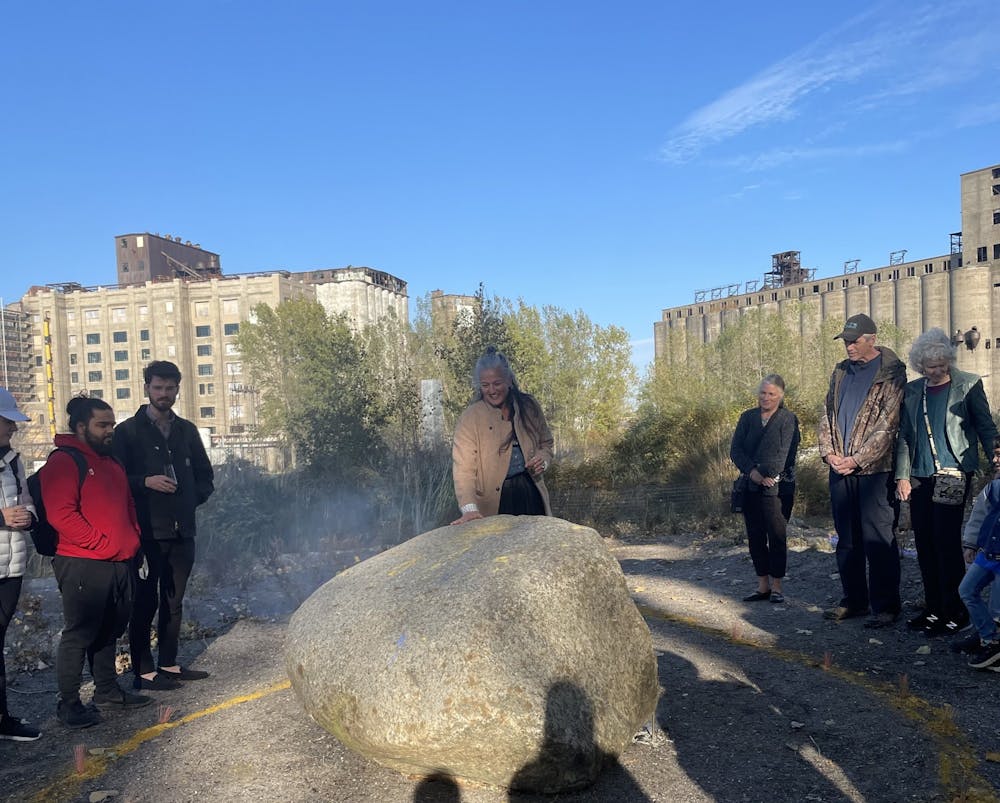The average college arts class doesn’t require digging in the dirt, moving boulders or planting thousands of flowers.
But for the past few weeks, students in UB’s Working Artists Lab have been doing just that — on the grounds of an abandoned industrial site.
With guidance from visiting artist Dara Friedman, a German-born film and video artist whose works have been exhibited at the Museum of Modern Art and the Hammer Museum, a group of adventurous students spent much of this semester constructing River Hill, a large-scale labyrinth and pollinator garden. Every week, they ventured to Silo City, a grain elevator-turned-creative and ecological campus situated in a bend of the Buffalo River, to work on the piece.
The unconventional class is a product of the UB Arts Collaboratory, an initiative created to foster artistic collaboration on campus and around the city of Buffalo. Each semester, a visiting artist joins the lab to work with UB students, collaborating on art and teaching them what it’s like to be a working creative in the 21st century.
Student artists represented various artistic disciplines, including everything from photography and sculpture to painting and theatre. The lab was even led by theatre professor Maria S. Horne and offered as course credit for theatre majors.
“Planting is not typically involved in theatre,” Jessica Snider, a senior theatre performance major and member of the lab, said. “[But] we definitely got to involve our artistic discipline into what we were doing.”
Snider calls the process of building the labyrinth as “artistic healing,” something that allowed the students to rethink their relationship to their art and themselves.
“I love working with my hands, I love playing with dirt,” Tim Nunez, a junior theatre performance major, said. “I got to do both.”
The labyrinth, designed by Friedman, was inspired by the meandering shape of the Buffalo River. This is Friedman’s second labyrinth project, the first having been constructed at a women’s shelter in Miami. These large-scale, environmental projects seem quite the departure from her usual work, but she finds the labyrinths to be cinematic.
“[Labyrinths] are obviously not movies, but for me, they sort of function similarly because they’re a landscape that you move through,” Friedman said. “And you get to tell yourself your own story as you’re doing it.”
With guidance from Josh Smith, the resident ecologist at Silo City, the students dug into a plot of land behind the Rigidized Metals Corporation building and filled it with thousands of seeds that will bloom into bee balm, mountain mint and hyssop.
The labyrinth serves many purposes. As a pollinator garden, it will contribute to the ecological rejuvenation of the site. As an artwork, it promotes oneness with nature, mindfulness and meditation.
But Friedman says the collaboration that went into constructing the labyrinth is just as important — if not more important — than the final product.
“It’s a meditation tool, which we’ve been using for, essentially, healing,” Friedman said of the collaborative project. “We’ve been talking about playing a long game over a short game, we’ve been talking about win-win solutions… We’ve been talking about peaceful conflict resolution.”
Now that the work is done, River Hill is a permanent part of Silo City’s environment. It will continuously evolve over the coming months, the flowers blooming and the work changing with the environment.
The labyrinth is public: anyone in need of a meditative space is welcome to walk through the human-made path. The experience of traversing it is up for interpretation, but Friedman hopes it will hold meaning for others.
“The labyrinth itself is a teacher and a classroom; it’s taught me so many things,” Friedman said.
Meret Kelsey is an assistant arts editor and can be reached at meret.kelsey@ubspectrum.com
Meret Kelsey is an assistant arts editor at The Spectrum.





